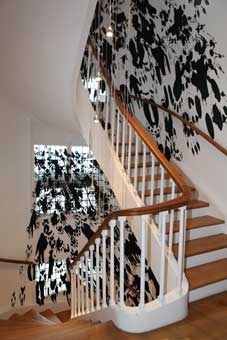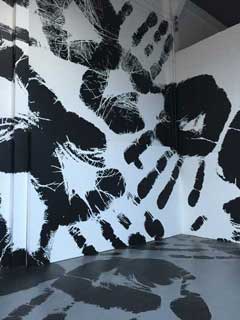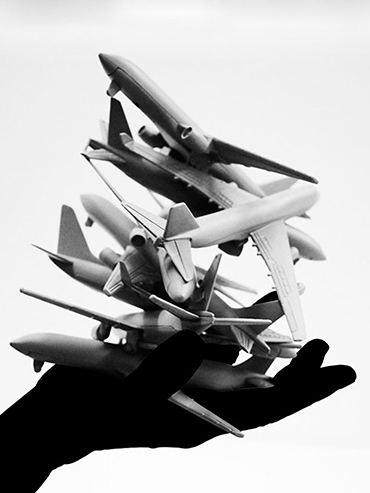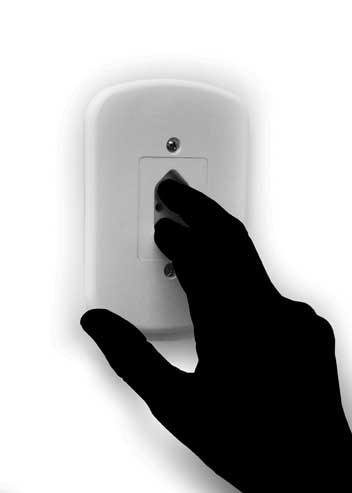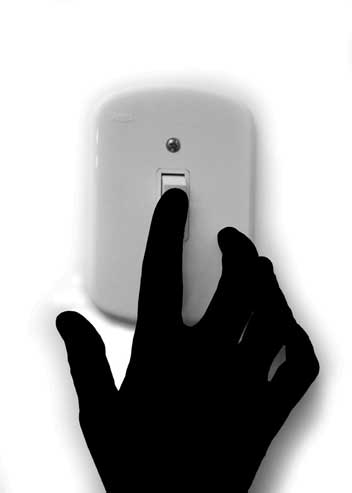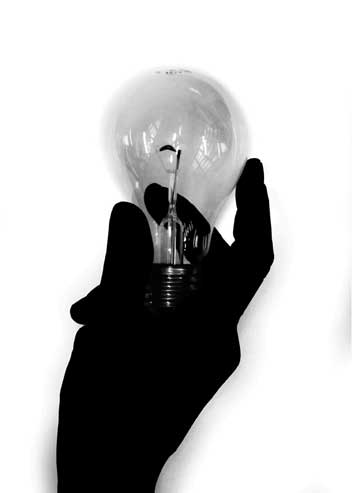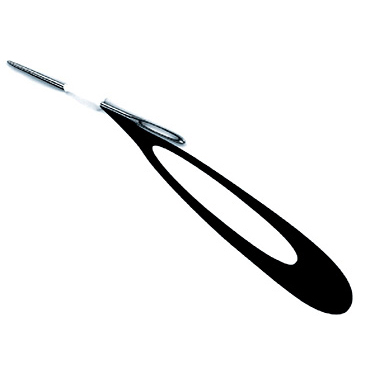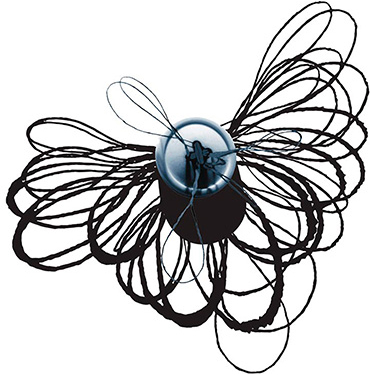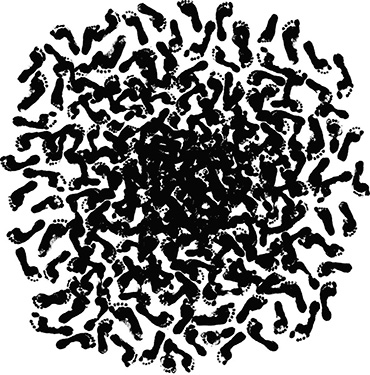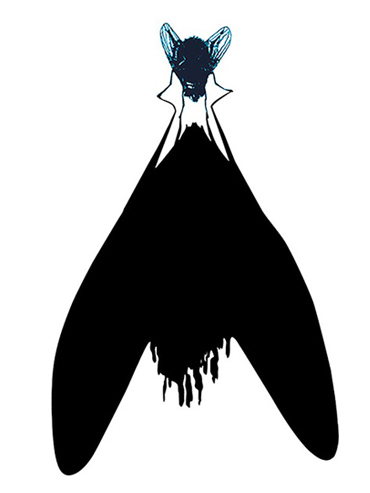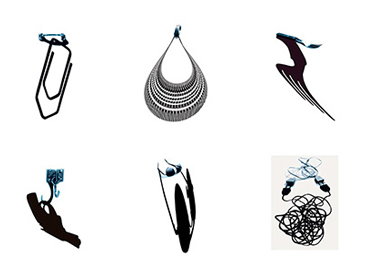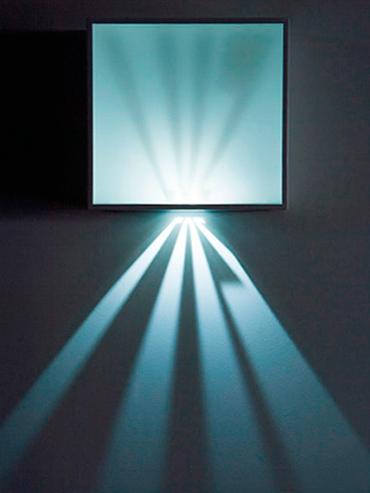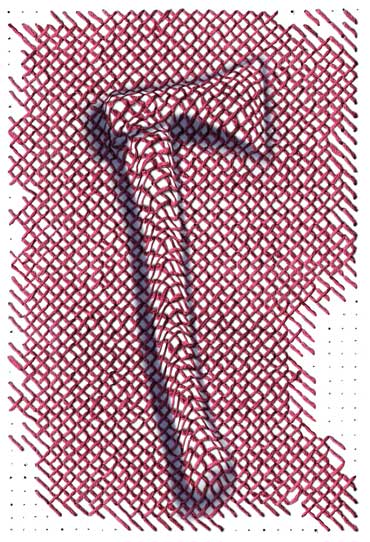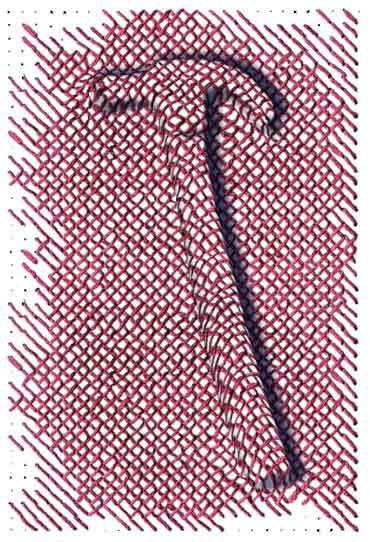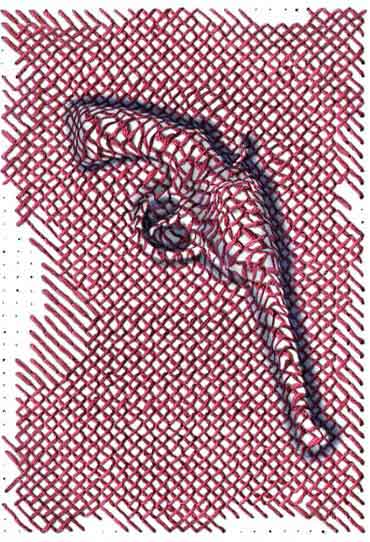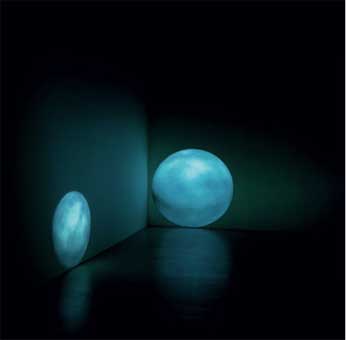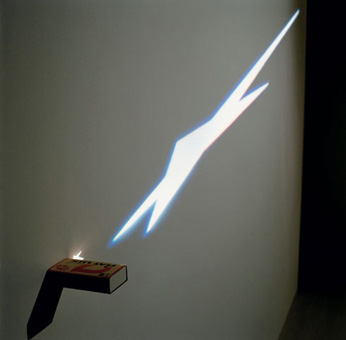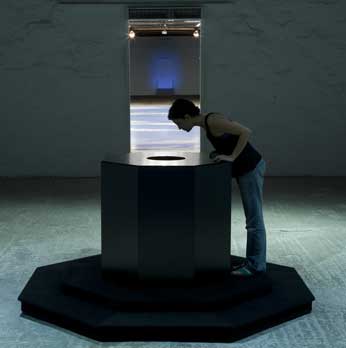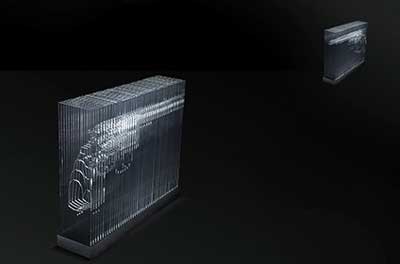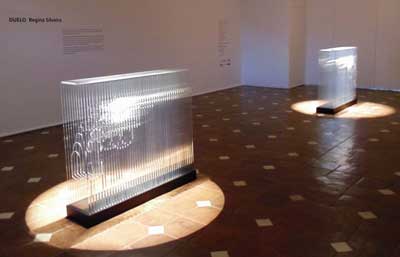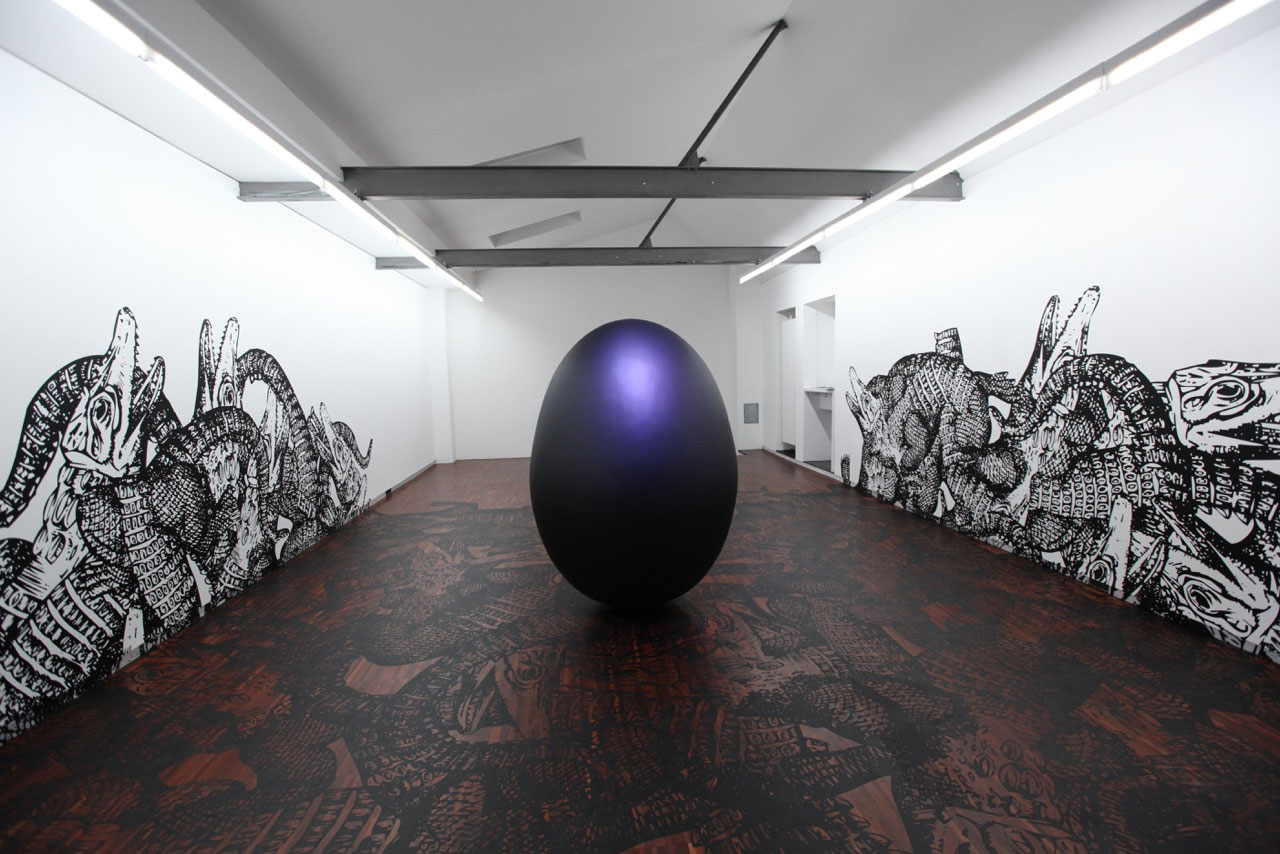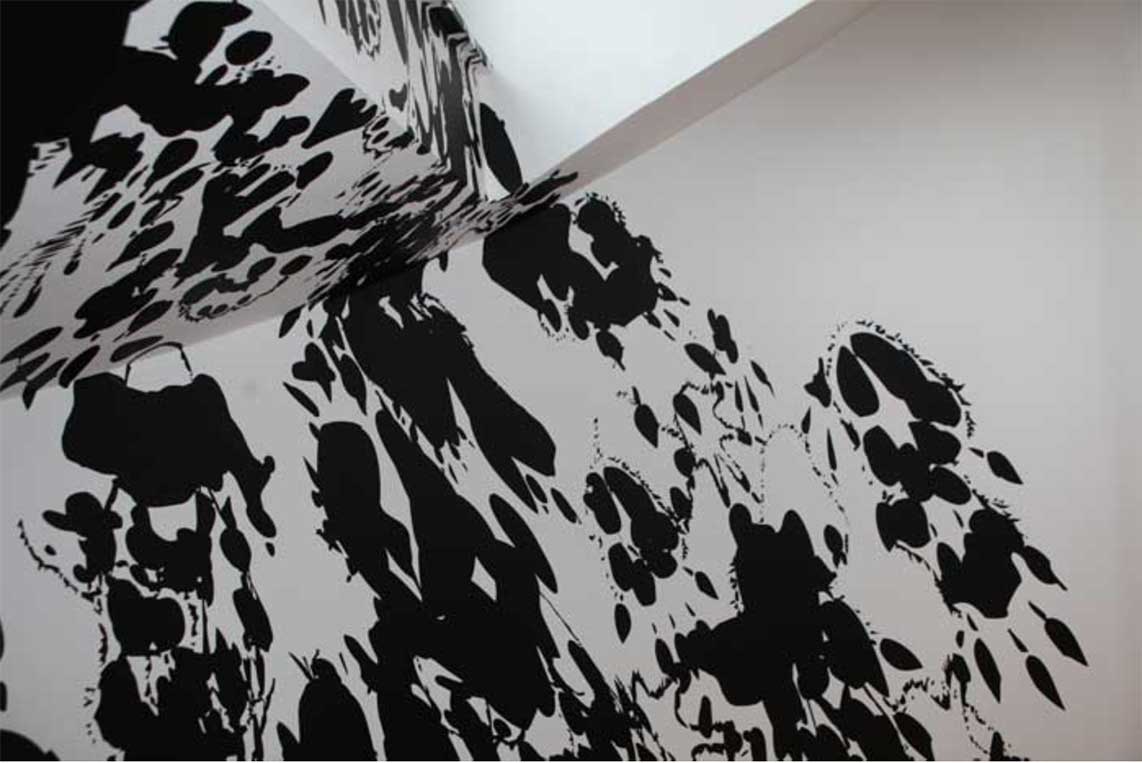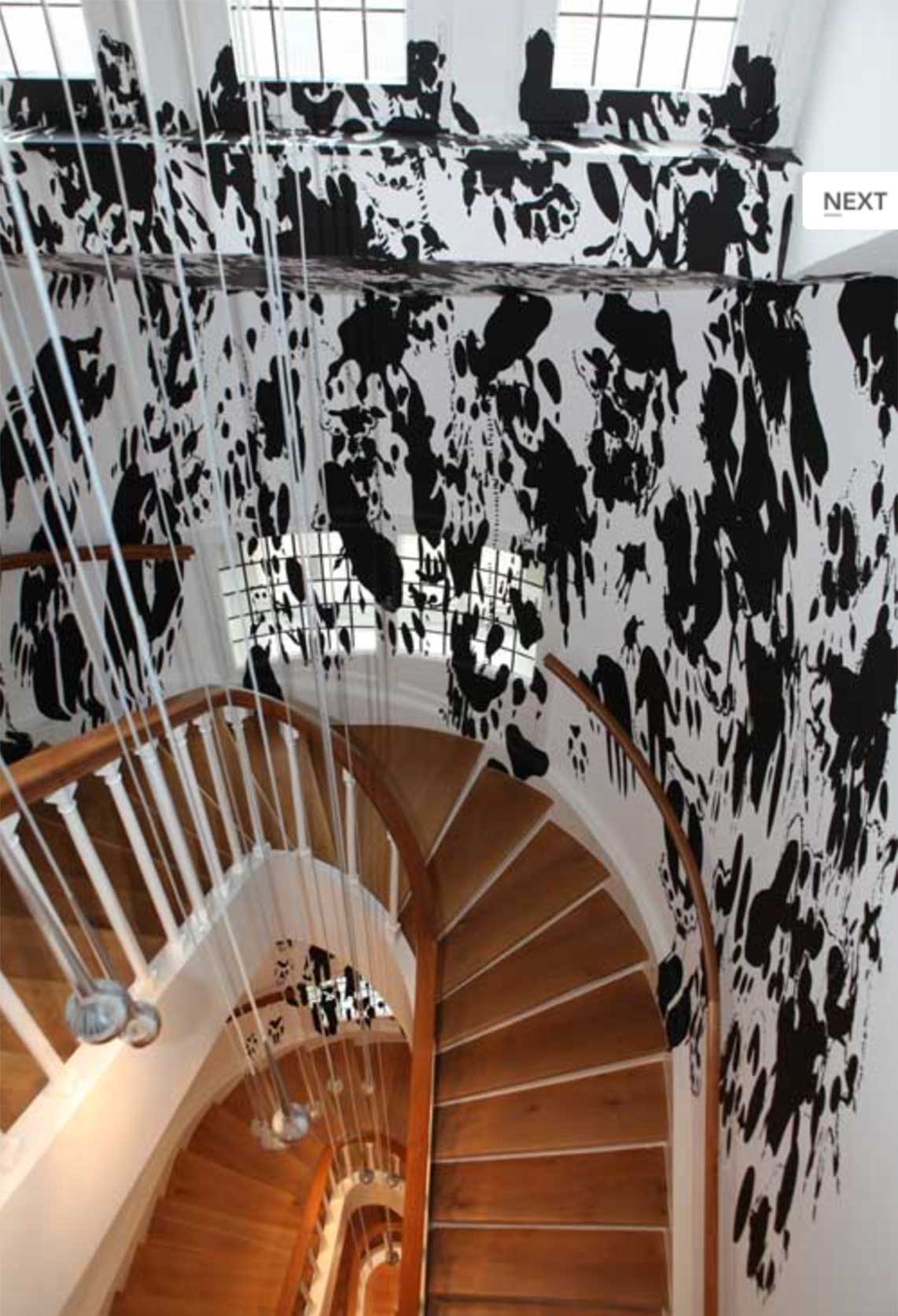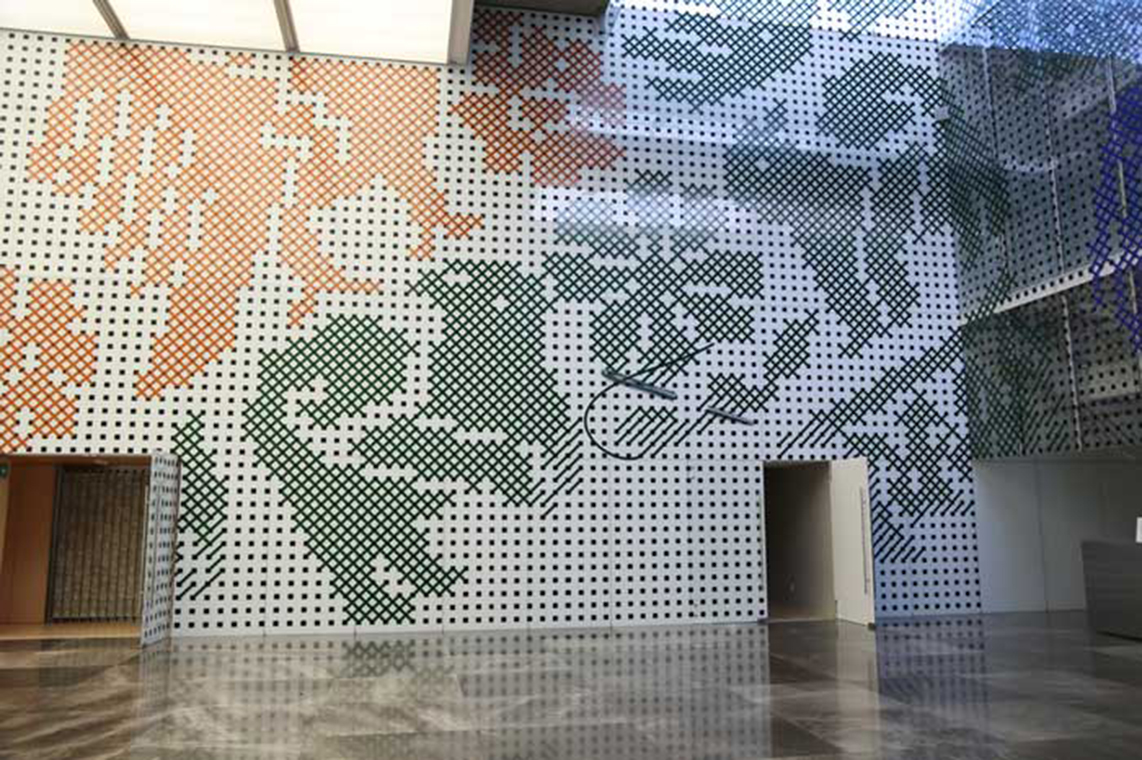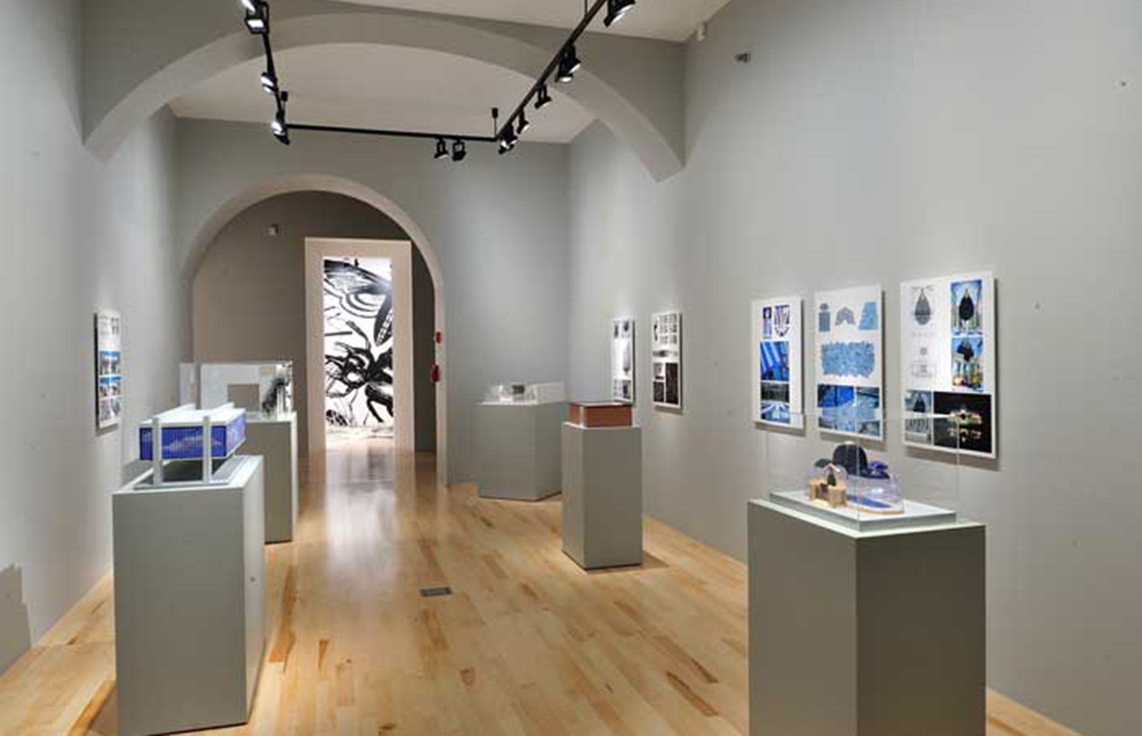Regina Silveira

1984 Escola de Comunicações e Artes da Universidade de São Paulo, Brazil
1980 Escola de Comunicações e Artes da Universidade de São Paulo, Brazil
1959 Instituto de Artes, Universidade Federa en Porto Alegre, Brazil
THE ART
Every outstanding artist is rooted in one or more traditions. Regina Silveira`s are pop art and conceptual art, the two main trends in art in the 20th and 21st centuries. Pop art was a rather material art, “hard” art, often presented in a traditional format: a painting, a sculpture. Conceptual art is rather an idea, not necessarily a hard object: it may be rebuilt a new and keep its art value intact. Regina`s art is both “hard” and conceptual. “Hard” because one can see the art piece there, on a wall, on the floor. Conceptual because the buyer not always necessarily acquires “a piece” from her, sometimes it may be just some instructions on how to produce the work, like a digital archive containing a matrix that can be developed, printed and installed even if the artist is not there (although most of the times she is). Everyday objects can still be found in Regina`s art just like in pop art (a hammer, a tyre, a sofa); but they are not direct representations of reality anymore: they are strong distortions of reality, ideas, allusions, symbols... Pop art still needed true colors (a blond hair, a green dollar bill, some red lips); Regina`s colors is black & white mainly: this is how reality is removed from her objects and only art remains and stands.
WHERE
Regina Silveira ́s art is for indoor as well as outdoors: museums, galleries, collector ́s rooms, corporate halls, public squares, buildings are all appropriate venues for her.
AT THE MoMA ALSO
Some of Regina Silveira`s works are in MoMA`s collection, among other museums, and in a number of prestigious private collections.
AROUND THE WORLD
Her agenda is a busy one, with exhibitions in the USA, Canada, Europe, Japan, Middle East all throughout the year. Biennials and Triennials welcome her participation and she is represented in the best art fairs. She has exhibited her works at the Guggenheim-New York, Houston Fine Arts Museum, MASP São Paulo, Reina Sofia-Madrid...
THE BACKGROUND
Regina has been an university professor as well for most of her life, which means knowledge, research and experiment are real values for her. And as a professor she has taught two generations of younger artists. She can’t be copied, though: her work is too personal and original.
- 2016 Setouchi Triennale, Ogijama, Japan
- 2015 “Contingent Beauty”, Museum of Fine Arts, Houston , USA
- 2014 Courtuld Institute of Art Museo Amparo, Puebla México
- 2013 Regina Silveira. Alexander Gray Associates. New York, USA
- 2012 Derrapagens, Solar do Barão, Fundação Cultural de Curitiba, Curitiba, Brasil
- 2011 Limits, Rubin Center for the Visual Arts, The University of Texas at El Paso, El Paso. USA. Wrap Project, Archon Group Deutschland, München, Germany
- 2010 Trama. Museu de Arte de São Paulo. MASP, Brasil
- 2009 Paseo Salvaje. Org. Centro Andaluz de Arte Contemporaáneo, Sevilla, España
- 2008 Mundus Admirabilis e Outras Pragas. Galeria Brito Cimino, São Paulo, Brasil
- 2007 Mundus Admirabilis, Jardim do Poder, Centro Cultural Banco do Brasil, Brasília, DF, Brasil
- 2006 Observatório, Projeto Octógono de Arte Contemporânea, Pinacoteca do Estado de São Paulo, SP, Brasil
- 2005 Sicardi Gallery, Houston, EEUU
- 2004 Desapariencia (Taller), El Cubo-Sala de Arte Público Siqueiros, Ciudad de México, México
- 2003 ClaraLuz, Centro Cultural Banco do Brasil, São Paulo, SP, Brasil
- 2002 A Lição, Galeria Brito Cimino, São Paulo, SP, Brasil
- 2001 Dobras, Atelier FINEP, Paço Imperial, Rio de Janeiro, RJ, Brasil
- 2000 Perpetual Transformation, Art Museum of the Americas, Washington, EEUU
- 1999 Desapariencias, Galeria Gabriela Mistral, Santiago, Chile
- 1998 Velox, Galeria Brito Cimino, São Paulo, SP, Brasil
- 1997 Intro (re:fresh widow, r.s.), Casa Triângulo, São Paulo, Brazil
- 1996 Grafias, Museu de Arte de São Paulo Assis Chateaubriand, São Paulo, Brazil
- 1995 Mapping the Shadows, LedisFlam Gallery, New York, NY
- 1994 Expandables, Brazilian-American Cultural Institute Art Gallery, Washington, DC
- 1993 Masterpieces (In Absentia), LedisFlam Gallery, New York, NY
- 1992 Encuentro, Bass Museum, Miami, FL
- 1991 Auditorium II (Black), Galeria Luisa Strina, São Paulo, Brazil
- 1990 Micro Hall Art Center, Edewecht, Germany
- 1989 Vértice, Museu de Arte Contemporânea da Universidade de São Paulo, Brazil
- 1988 Projectio, Fundação Calouste Gulbenkian, Lisboa, Portugal
- 1987 Inflexões, Arte Galeria, Fortaleza, Ceará and Galeria Luisa Strina, São Paulo, Brazil
- 1985 Museu de Arte Contemporânea do Paraná, Curitiba, Paraná, Brazil
- 1984 Simulacros, Museu de Arte Contemporânea da Universidade de São Paulo, Brazil
- 1982 Anamorfas, Museu de Arte Moderna do Rio de Janeiro, Brazil
- 1980 Anamorfas, Museu de Arte Contemporânea da Universidade de São Paulo, Brazil
- 1978 Regina Silveira: Obra Gráfica 71-77, Pinacoteca do Instituto das Artes da Universidade Federal do Rio Grande do Sul, Porto Alegre, Rio Grande do Sul, Brazil
- 1977 Gabinete das Artes Gráficas, São Paulo, Brazil
- 1975 Centro de Arte y Comunicación, Buenos Aires, Argentina Gabinete das Artes Gráficas, São Paulo, Brazil
- 1973 Sala de Arte, Mayaguez, Puerto Rico Galeria Seiquer, Madrid, Spain
- 1970 Sala de Arte, Mayaguez, Puerto Rico
- 1968 Galeria U, Montevideo, Uruguay
- 1961 Museu de Arte do Rio Grande do Sul, Porto Alegre, Rio Grande do Sul, Brazil
Alexander Gray Associates, New York, USA
Galerie Stöckle Hauser, Stuttgart, Germany
Luminato Festival, Toronto, Canada
Metáforas Construidas. Galeria Lacometa, Bogotá, Colombia
Crash. Museu Oscar Niemeyer, Curitiba, Brazil
Grafias e Bordados. Museu Chácara do Céu, Rio de Janeiro, Brazil
Bienale de La Habana, Cuba
Amercia Latians Photgraphs, Fondation Cartier, Paris
Fora de Escala | Offscale. Luciana Brito Galeria. São Paulo, Brazil Octopus. SCAD Museum of Art. Savannah, Georgia, USA
Exposicion Extranjerías, Museo Universitario Arte Contemporáneo, Mexico City, México
In Absentia (Masterpieces), The Aldrich Contemporary Art Museum, Ridgefield, Connecticut. USA
Entre trópicos: 46005, Caixa Cultural, Rio de Janeiro, Brasil
Regina Silveira . Galeria Vilaseco Hauser, La Coruña , España
Shadow Line, Alexander Gray Associates, New York, USA
Thousand and one day, and other puzzles, Iberê Camargo Foundation, Porto Alegre, Brasil
Abyssals. Atlas Sztuki Foudation, Lodz, Polonia
Ocupação. Instituto Itaú Cultural, São Paulo, Brasil
Meialuz. Centro Universitário Maria Antonia, São Paulo, Brasil
Ex Orbis. Escola de Artes Visuais do Parque Lage, Rio de Janeiro, Brasil
Glossário, intervenção na fachada Hospital Edmundo Vasconcelos, São Paulo, Brasil
Derrapagens. Galeria Bolsa de Arte, Porto Alegre, Brasil
Octopus, Alexander Gray Associates, New York, USA
O olho e o lugar. Espaço Caixa Cultural, São Paulo, Brasil
Linha de Sombra. Centro Cultural Banco do Brasil, Rio de Janeiro, Brasil. Passeio Selvagem. Org. SESC Santana, São Paulo, Brasil
Tropel (Reversed). Kunstmuseet Koge Skitsesamling, Koge, Dänemark
Sombra Luminosa. Museo de Antioquia, Medellin, Colombia
Umbrales. Galeria Metta, Madrid, España.
Outgrown (Tracks and Shadows), Philip Feldman Gallery, Pacific Northwest College of Art, Port- land, EEUU
Sombra Luminosa, Museo de Arte del Banco de la Republica, Bogotá, Colombia
Compêndio [rs], Museu de Arte da Pampulha, Belo Horizonte, MG, Brasil
Double and Lunar. Visual Arts Gallery, India Habitat Centre, Nueva Delhi, India.
Luz-Zul, Centro Cultural Telemar, Rio de Janeiro, RJ, Brasil
Huellas & Sombras, Galería de Artes Visuales de la Universidad Ricardo Palma, Lima, Perú
Eclipse. Parque José Ermínio de Moraes Filho, Curitiba, Brasil
Lumen, Palacio de Cristal, Museo Nacional Centro de Arte Reina Sofía, Madrid, España
Tracking Over, Centro Cultural España, Montevideo, Uruguay
Derrapagem, Projeto Parede, Museu de Arte Moderna de São Paulo, SP, Brasil
Teorema da Gaveta. Instituto de Ciências Matemáticas e de Computação da Universidade de São Paulo, São Carlos, Brasil
Dueto/Duelo, Palácio da Abolição, Fortaleza, CE, Brasil
Desaparências (Estúdio), Torreão, Porto Alegre, RS, Brasil
Ex-Orbis. Aeroporto Internacional Salgado Filho, Porto Alegre, Brasil.
Equinócio, Pavilhão das Cavalariças, Parque Lage, Rio de Janeiro, RJ, Brasil
Ex Orbis - Making of, SENAC, São Paulo, SP, Brasil
Blue Star Art Center, San Antonio, USA
Museo de Arte Moderno de Buenos Aires, Argentina
Super-Herói - Night and Day. Museo de Arte Moderno de Buenos Aires, Argentina
To be Continued..., Northern Illinois University Art Museum, Chicago, IL
Gone Wild: Inside/Out Series, Museum of Contemporary Art, San Diego, CA
Velox, Galleria Il Gabbiano, La Spezia, Italy
Regina Silveira: Desenhos, AS Studio, São Paulo, Brazil
Museu de Arte do Rio Grande do Sul, Porto Alegre, Rio Grande do Sul, Brazil
In Absentia (Stretched): Contemporary Currents Series, Queens Museum of Art, Queens, NY Simile: Office 2, LedisFlam Gallery, New York, NY
Interiors, Mitchell Museum, Mount Vernon, IL
On Absence: Office Furniture, One American Center Building, Austin, TX
Auditorium II, Cooperativa de Actividades Artísticas Árvore, Porto, Portugal
Galeria Luisa Strina, São Paulo, Brazil
Galeria Arte & Fato, Porto Alegre, Rio Grande do Sul, Brazil
Museu de Arte do Rio Grande do Sul, Porto Alegre, Rio Grande do Sul, Brazil
Sombras, Museu de Arte do Rio Grande do Sul, Porto Alegre, Rio Grande do Sul, Brazil
Sombras, Museu de Arte do Rio Grande do Sul, Porto Alegre, Rio Grande do Sul, Brazil
Museu de Arte do Rio Grande do Sul, Porto Alegre, Rio Grande do Sul, Brazil
- 2013 Permission To Be Global: Latin American Art from the Ella Fontanals-Cisneros Collection / Practicas Globales: Arte de Latinoamérica en la Colección de Ella Fontanals-Cisneros, curated by Jen Mergel and Liz Munsell, CIFO Art Space, Miami, FL
- 2012 The Enclosed Openess: Box and Book in Brazilian Art, curated by Guy Brett, Pinacoteca Estado de São Paulo, São Paulo, Brazil
- 2011 11th Biennale of Cuenca-Ecuador, Cuenca, Ecuador
- 2009 PINTA, The Modern & Contemporary Latin American Art Fair, New York, NY XV Bienal de Cerveira, Vila Nova de Cerveira, Portugal
- 2008 Programa 07, Mostra Os Pioneiros, curated by Arlindo Machado, Museu da Imagen e do Som, São Paulo, Brazil
- 2007 Ctrl C + Ctrl V, SESC Pompéia, São Paulo, Brazil
- 2006 6th Taipei Biennial: Dirty Yoga, Taipei, Taiwan Gravura Contemporânea Brasileira, Museu de Arte Contemporânea do Ceará, Fortaleza, Ceará, Brazil A Luz da Luz, SESC Pinheiros, São Paulo, Brazil Manobras Radicais, Centro Cultural Banco do Brasil, São Paulo, Brazil Futebol É Coisa de 11, Galeria do Lago, Rio de Janeiro, Brazil A Cidade para a Cidade, Galeria Olido, São Paulo, Brazil
- 2005 World Performing Arts Festival 2005, Lahore, Pakistan
- 2004 2004 Versão Brasileira, Galeria Brito Cimino, São Paulo, Brazil
- 2003 Subversão dos Meios, Instituto Itaú Cultural, São Paulo, Brazil
- 2002 Matéria Prima, NovoMuseu de Arte, Arquitetura e Cidade, Curitiba, Paraná, Brazil
- 2001 Virgin Territory, The National Museum of Women in the Arts, Washington, DC
- 2001 Trajetória da Luz na Arte Brasileira, Instituto Itaú Cultural, São Paulo, Brazil
- 2000 Arte Conceitual e Conceitualismos, Museu de Arte Contemporânea da Universidade de São Paulo, Brazil
- 1999 Passion For Wings, National Aviation Museum, Ottawa, Canada
- 1998 Arte Contemporânea Brasileira: Um/e/entre Outro/s, curated by Paulo Herkenhoff and Adriano Pedrosa, XXIV Bienal Internacional de São Paulo, Brazil
- 1997 Diversidade da Escultura Brasileira Contemporânea, Instituto Cultural Itaú, São Paulo, Brazil Re-Aligning Vision: Alternative Currents in South American Drawing, El Museo del Barrio, New York, NY Museo de Bellas Artes, Caracas, Venezuela Museo de Arte Contemporâneo, Monterrey, Mexico Ao Cubo, Paço das Artes, São Paulo, Brazil Arte/Lixo, Agência Observatório, São Paulo, Brazil Of Mudlarkers and Measurers, Agnes Etherington Art Centre, Kingston, Canada Ottawa Art Gallery, Canada Galeria Brito Cimino, São Paulo, Brazil
- 1996 Arte Brasileira Contemporânea: Doações Recentes, Museu de Arte Moderna de São Paulo, Brazil
- 1995 Prints, Brooke Alexander Gallery, New York, NY Livro-Objeto: A Fronteira dos Vazios, Museu de Arte Moderna de São Paulo, Brazil Children’s Corner, Galeria Il Gabbiano, La Spezia, Italy O Desenho em São Paulo: 1956-1995, Galeria Nara Roesler, São Paulo, Brazil
- 1994 Arte/Cidade: A Cidade e seus Fluxos, São Paulo, Brazil Recovering Popular Culture, El Museo del Barrio, New York, NY Bienal Brasil Século XX, Fundação Bienal de São Paulo, Brazil
- 1993 Drawings: 30th Anniversary Exhibition, Leo Castelli Gallery, New York, USA Ultramodern: The Art of Contemporary Brazil, The National Museum of Women in the Arts, Washington, DC Women at War, LedisFlam Gallery, New York, NY
- 1992 Imaquinaciones: 16 Miradas al 92, EXPO 92, Sevilla, Spain International Festival, Houston, TX
- 1991 Imaquinaciones: 16 Miradas al 92, Ciudad de México, Mexico Brazilian Art Today, Grey Art Gallery, New York, NY Disimilar Identity, Scott Alan Gallery, New York, NY VII India Triennale, New Delhi, India Studio Internacional de Tecnologias da Imagem, SESC Pompéia, São Paulo, Brazil
- 1990 Panorama da Arte Atual Brasileira: Papel, Museu de Arte Moderna de São Paulo, Brazil Gente de Fibra, SESC Pompéia, São Paulo, Brazil
- 1989 O Pequeno Infinito e o Grande Circunscrito, ARCO Galeria de Arte, São Paulo, Brazil
- 1988 Lo Permeable del Gesto, Centro Cultural Galileo, Madrid, Spain Copy Art Show, orgnized by Other Books & So Archive, Tolosa, Spain Panorama da Arte Atual Brasileira: Formas Tridimensionais, Museu de Arte Moderna de São Paulo, Brazil
- 1987 A Trama do Gosto, Fundaç ão Bienal de São Paulo, Brazil
- 1986 A Nova Dimensão do Objeto, Museu de Arte Contemporânea da Universidade de São Paulo, Brazil Couriers: Six Brazilian Artists, Snug Harbor Cultural Center, New York, USA
- 1985 Tendências do Livro de Artista no Brasil, Centro Cultural São Paulo, Brazil Destaques da Arte Brasileira Contemporânea, Museu de Arte Contemporânea da Universidade de São Paulo, Brazil Arte Novos Meios/Multimeios: Brasil 70/80, Museu de Arte Brasileira, Fundação Armando Álvares Penteado, São Paulo, Brazil
- 1984 A Xilogravura na História da Arte Brasileira, Funarte, Rio de Janeiro, Brazil I Bienal de La Habana, Cuba
- 1983 XVII Bienal Internacional de São Paulo, Brazil VI Bienal Del Grabado Latinoamericano, San Juan, Puerto Rico
- 1982 Artemicro, curated by Regina Silveira and Rafael França, Museu da Imagem e do Som, São Paulo, Brazil
- 1981 IV Bienal Americana de Artes Gráficas, Cali, Colombia XVI Bienal Internacional de São Paulo, Brazil Mostra de Video, Centro de Estudos Áster, São Paulo, Brazil
- 1979 Lis’ 79: International Exhibition of Drawings, Lisboa, Portugal
- 1978 From Bookworks to Mailworks, Alkmaar Municipal Museum, Alkmaar, Holland Fiatal Mûvészak Klubja, Budapest, Hungary Primera Encontro Internacional de Video-Arte de São Paulo, Brazil
- 1977 50 Artistas Latinoamericanos, Fundació Juan Miró, Barcelona, Spain
- 1976 10th Biennial Exhibition of Prints, Tokyo, Japan Latin American Graphics, University of Lund, Sweden 20 Artistas Brasileños, Museu de Belas Artes de Bahia Blanca, Bahia Blanca, Argentina
- 1974 Prospectiva [Prospective], Museu de Arte Contemporânea da Universidade de São Paulo, Brazil
- 1973 Premio Internazionale Biella per L'Incizione, Biella, Italy
- 1970 40 Gravuras Nacionais e Estrangeiras do Acervo do MAC, “Museu de Arte Contemporânea, Olinda, Brazil
- 1968 Exposición Internacional de Dibujo, Mayaguez, Puerto Rico Super-Herói - Night and Day. Museo de Arte Moderno de Buenos Aires, Argentina Intro (re:fresh widow, r.s.), Casa Triângulo, São Paulo, SP, Brasil To be Continued..., Northern Illinois University Art Museum, Chicago,USA
América Latina 1960-2013, Fondation Cartier, Paris, France
“Museo Amparo, Puebla, Mexico
Conceptual Geographies: Frames and Documents: Selections from the Ella Fontanals- Cisneros Collection, Miriam and Ira D. Wallach Art Gallery, Columbia University, New York, NY
Bienal Internacional de Curitiba 2013, Curitiba, Brazil
O Cotidiano na Arte, Torre Santander, São Paulo, Brasil
Projection, Artistic Director Jorn Weisbrodt, Luminato Festival, Toronto, Canada
Seminario Transmuseu, Museu de Arte Moderna de São Paulo, Brazil
Touch, curated by Denise Mattar, Paco das Artes, São Paulo, Brazil
Tropel Reversed, Main Palace, Frankfurt, Germany”
Encontros de Arte e Gastronomia: Tsuyoshi Murakami + Regina Silveira, Museo de Arte Moderna, São Paulo, Brazil
1001 Days (Hatchway), Luminale Festival, Kunsthalle, Detroit, Michigan
Design de Carros no Brasil: Rupturas e Inovacoes, Casa Fiat de Cultura Belo Horizonte, Minas Gerais, Brazil
PARALER, Biblioteca Municipal Mario Andrade, São Paulo, Brazil
Mundus Admirabilis & Rerum Naturae, Mediations Biennale, Poznan, Poland
Common Pavillions: Diener & Diener with Gabriele Basilico, 13th Architecture International Exhibition, La Biennale di Venezia, Venice, Italy
From the Margin to the Edge, Somerset House, London, England
Par Avion, Biblioteca Municipal, São Paulo, Brazil
Passato Imediato, Galeria Marta Traba Memorial da America Latina São Paulo, Brazil
Pegou Levou- 100 Souvenirs, Atelier Ponto, São Paulo, Brazil
Gravura em Campo Expandido, Pinacoteca do Estado de São Paulo, São Paulo, Brazil
Obra Viva: Permanent Sculptures at the Parque Estoril, São Bernardo do Campo, São Paulo, Brazil
Projeto Bordallianos Brasileiros, Museo Bordallo Pinheiro, Caldas da Rainha, Portugal
Regina Silveira: Limits, Rubin & L Galleries, Stanlee & Gerald Rubin Center for the Visual Arts at the University of Texas El Paso
Exposição Geopoéticas, Fundação Bienal do Mercosul, Porto Alegre, Brazil
¡No más chicha, Cervecería Andina, Galeria Alcuadrado, Bogotá, Colombia
Um Mundo Sem Molduras, Museu de Arte Contemporânea da Universidade de São Paulo, Brazil
White Noise, De Pauw University, Greencastle, IN
Blicksmachinen, Mucsarnok Kunsthalle, Budapest, Hungary
Blickmaschinen, Museum fur Gegenwartskunst, Siegen, Germany
An Unruly History of the Readymade, Fundación/Colección Jumex, Ciudad de México, Mexico Duchamp-Me, Sala Paulo
Figueiredo, Museu de Arte Moderna de São Paulo, Brazil
Ensaios, Largo das Artes, Largo de São Francisco, Rio de Janeiro, Brazil
Marked Pages II: Drawings, Sicardi Gallery, Houston, TX
Arte no Brasil 1911–1980: Estratégias para Entrar e Sair da Modernidade, Coleção Itaú Moderno, Museu de Arte de São Paulo, Brazil
Arte Contemporânea: Aquisições Recentes do Acervo da Pinacoteca do Estado, Pinacoteca do Estado de São Paulo, Brazil
Celebrating Prints: Recent Acquisitions, Vivian and Gordon Gilkey Center for Graphic Arts, Portland Art Museum, Portland, OR Arte pela Amazônia, Fundação Bienal de São Paulo, Brazil
Space Invaders, Museum of the Americas, Denver, CO
Phantasmagoria: Specters of Absence, McColl Center for Visual Arts, Charlotte, NC
The John and Mable Ringling Museum of Art, Sarasota, FL
Fisher Gallery, University of Southern California, Los Angeles, CA
Memória do Futuro, Instituto Itaú Cultural, São Paulo, Brazil
Itaú Contemporâneo: Arte no Brasil 1981-2006, Instituto Itaú Cultural, São Paulo, Brazil
Phantasmagoria: Specters of Absence, Museo de Arte del Banco de la República, Bogotá, Colombia
The Contemporary Art Museum, Honolulu, HI
Aquisições Recentes, Museu de Arte de São Paulo Assis Chateaubriand, São Paulo, Brazil
Super-X (Night), Virada Cultural, São Paulo, Brazil2004
Desapariencia (Taller), El Cubo-Sala de Arte Público Siqueiros, Ciudad de México, México
Tracking Over, Centro Cultural España, Montevideo, Uruguay
Derrapagem, Projeto Parede, Museu de Arte Moderna de São Paulo, SP, Brasil
Indelible Images, The Museum of Fine Arts, Houston, TX
La Médiatine: Corps en Mouvement, Brussel, Belgium
A Imagem do Som, Paço Imperial, Rio de Janeiro, Brazil
The Shadow, Vestsjaellands Kunstmuseum, Soro, Denmark Campos Latinoamericanos, Galería Alcuadrado, Bogotá, Colombia
Trienal Poli/Gráfica de San Juan, Puerto Rico
Still Life: Natureza Morta, Galeria de Arte do SESI, São Paulo, Brazil
In Situ, Centro Cultural São Paulo, Brazil
Estratégias Barrocas: Arte Contemporáneo Brasileño, Centro Cultural Metropolitano, Quito, Equador
We Come in Peace... Histories of the Americas, Musée d’Art Contemporain, Montreal, Canada
Persistante Perspective, Ecole Supérieure des Beaux-Arts du Mans, Les Mans, France
ArteConhecimento 70 Anos USP, Museu de Arte Contemporânea da Universidade de São Paulo, Brazil
Palavra Extrapolada, SESC Pompéia, São Paulo, Brazil
Imagética, Fundação Cultural de Curitiba, Curitiba, Paraná, Brazil
Fiat Lux:A Luz Como Criação na Arte, Centro Cultural da Justiça Federal, Rio de Janeiro, Brazil
ArteFoto, Centro Cultural Banco do Brasil, Brasília, Brazil
Centro Cultural Banco do Brasil, Rio de Janeiro, Brazil
Arte e Sociedade: Uma Relação Polêmica, Instituto Itaú Cultural, São Paulo, Brazil
Layers of Brazilian Art, Faulconer Gallery, Grinnel, IA
ArteFoto, Centro Cultural Banco do Brasil, Rio de Janeiro, Brazil
Do Conceito ao Espaço, Instituto Tomie Ohtake, São Paulo, Brazil
Arquipélagos: O Universo Plural, Museu de Arte Moderna do Rio de Janeiro, Brazil
Caminhos do Contemporâneo 1952-2002, Paço Imperial, Rio de Janeiro, Brazil
Estratégias para Deslumbrar, Museu de Arte Contemporânea da Universidade de São Paulo, Brazil
Brazil: Body and Soul, Guggenheim Museum, Bilbao, Spain
Artecidadezonaleste, SESC Belenzinho, São Paulo, Brazil
Bienal del Grabado, Museo del Grabado, Buenos Aires, Argentina
Brazil: Body and Soul, Guggenheim Museum, New York, NY
The Overexcited Body: Arte e Esporte na Sociedade Contemporânea, SESC Pompéia, São Paulo, Brazil
Rede de Tensão: Bienal 50 Anos, Fundação Bienal de São Paulo, Brazil
I Bienal de Artes do Cariri, Galpão da Usina José Bezerra, Juazeiro do Norte, Ceará, Brazil
Esercizi di Stile, Museo dell’Informazione e di Arte Contemporanea de Senigaglia, Ancona, Italy
São ou Não Gravuras?, Museu de Arte Moderna Villa Lobos, São Paulo, Brazil
Rembrandt to Rauschenberg: Building the Collection, Jack S. Blanton Museum of Art, Austin, TX
Obra Nova, Museu de Arte de Contemporânea da Universidade de São Paulo, Brazil
I Bienal Argentina de Grafica Latino Americana, Museu Nacional del Grabado, Buenos Aires, Argentina
Puerto Rico 00 [Paréntesis en la Ciudad], M & M Proyectos, Museo de Arte de Puerto Rico, and alternative spaces, San Juan, Puerto Rico
O Papel da Arte, Museu de Arte Contemporânea da Universidade de São Paulo, Brazil
Situações: Arte Brasileira Anos 70, Fundação Casa França-Brasil, Rio de Janeiro, Brazil
The Egg Dream Museum: The Nutrition Pavilion, Expo 2000, Hannover, Germany
Ano III, Galeria Brito Cimino, São Paulo, Brazil
Homenaje Al Lápiz Como Instrumento de Libertad, Museu José Luis Cuevas, Ciudad de México, Mexico
II Bienal do Mercosul, Porto Alegre, Rio Grande do Sul, Brazil
Re-Aligning Vision: Alternative Currents in South American Drawing, Miami Art Museum, Miami, FL
Mastering the Millennium: Art of the Americas, Art Museum of the Americas and World Bank Art Program, Washington, DC
Arte de Las Americas: El Ojo del Milenio, Centro Cultural Recoleta, Buenos Aires, Argentina
Por que Duchamp?, Paço das Artes, São Paulo, Brazil
O Brasil no Século da Arte – Coleção MAC/USP, Galeria de Arte do SESI, São Paulo, Brazil
100 Drawings, P.S.1 Contemporary Art Center, Long Island, NY
Clocktower Gallery, New York, NY
Parallèle Brito Cimino/FIAC, Galeria Brito Cimino, São Paulo, Brazil
Doações Recentes, Museu de Arte Moderna de São Paulo, Brazil
Stelle Cadenti, Associazione Culturale per L’Arte Contemporânea, Bassano in Teverina, Italy
Horizonte Reflexivo, Centro Cultural Light, Rio de Janeiro, Brazil
Salão Nacional de Artes Plásticas, Museu de Arte Moderna do Rio de Janeiro, Brazillo, Brazil
UFO, Virada Cultural, São Paulo, Brazil
The Image of Sound: Football, Haus der Kulture der Welt, Berlin, Germany
Tracing Shadows, The Israel Museum, Jerusalem, Israel
Dobras, Atelier FINEP, Paço Imperial, Rio de Janeiro, RJ, Brasil.
- Agnes Etherington Art Center, Kingston, Canada
- Coleção Centro de Arte Contemporânea Inhotim, Brumadinho, Brazil
- Coleção Centro Dragão do Mar Arte e Cultura, Fortaleza, Brazil
- Coleção Itaú, São Paulo, Brazil
- Coleção SESC, São Paulo, Brazil
- El Museo del Barrio, New York, USA
- Foundation for Contemporary Performance Arts, New York, USA
- Mitchell Museum, Mount Vernon, USA
- Museo de Arte Moderno de Buenos Aires, Argentina
- Museu de Arte Contemporânea da Universidade de São Paulo, Brazil
- Museu de Arte Contemporânea do Paraná, Curitiba, Brazil
- Museu de Arte de São Paulo Assis Chateaubriand, São Paulo, Brazil
- Museu de Arte do Rio Grande do Sul, Porto Alegre, Brazil
- Museu de Arte Moderna de São Paulo, Brazil
- Museu de Arte Moderna do Rio de Janeiro, Brazil
- Pinacoteca do Estado de São Paulo, Brazil
- Pinacoteca do Inst. de Artes da U. Federal do Rio Grande do Sul, Porto Alegre, Brazil
- Pinacoteca Municipal de São Paulo, Brazil
- San Diego Museum of Contemporary Art, La Jolla, USA
- aipei Fine Arts Museum, Taiwan
- The Jack S. Blanton Museum of Art, University of Texas, Austin, USA
- The Museum of Modern Art, New York, USA
- The Queens’ Museum of Art, New York, USA
EXPOSICIÓN LILITH'S DREAM · 2013/2014
GALERIE STÖCKLEHAUSER STUTTGART
In Dark Swamp (2011) the far-reaching theme is the transposition of the biblical, mythical and historic plagues to nonlinear metaphors that could poetically allude to the plagues manifestations in contemporaneity. Conceptual updating is focused on the way other plagues could beset us today, in a range of social and environmental contexts, jeopardizing the future.
Dark Swamp metaphorically alludes to power, evil, or to the evilness of power, as well as destiny and prophecy. The elements acting as symbolic supports for Dark Swamp are the extended graphic appropriated image of alligators and a black egg, with oversized proportions. Laid at the center of the alligators pattern, the egg simulates an undesired gestation that expands circularly like an uncontrollable stain, with the potential to grow in any direction, in continuous replication.
Quimera is a visual paradox consisting of the image of a switched-on light bulb projecting not light, but a vast shadow in the form of a black stain or extended black drop, as if the shadow would be pouring out from the ligh bulb. In Quimera the light bulb is made as a shaped stained glass backlight, and the shadow is designed and executed as an adhesive vinyl cutout. Quimera was first shown in the artist’s solo exhibition Claraluz, at the Centro Cultural Banco do Brasil in Sao Paulo 2003. Its largest version was a hanging giant double backlight, placed at the Palácio de Cristal façade, for her solo exhibiton Lumen (2005), Museo Reina Sofia, Madrid (2005).
Regina Silveira 2013
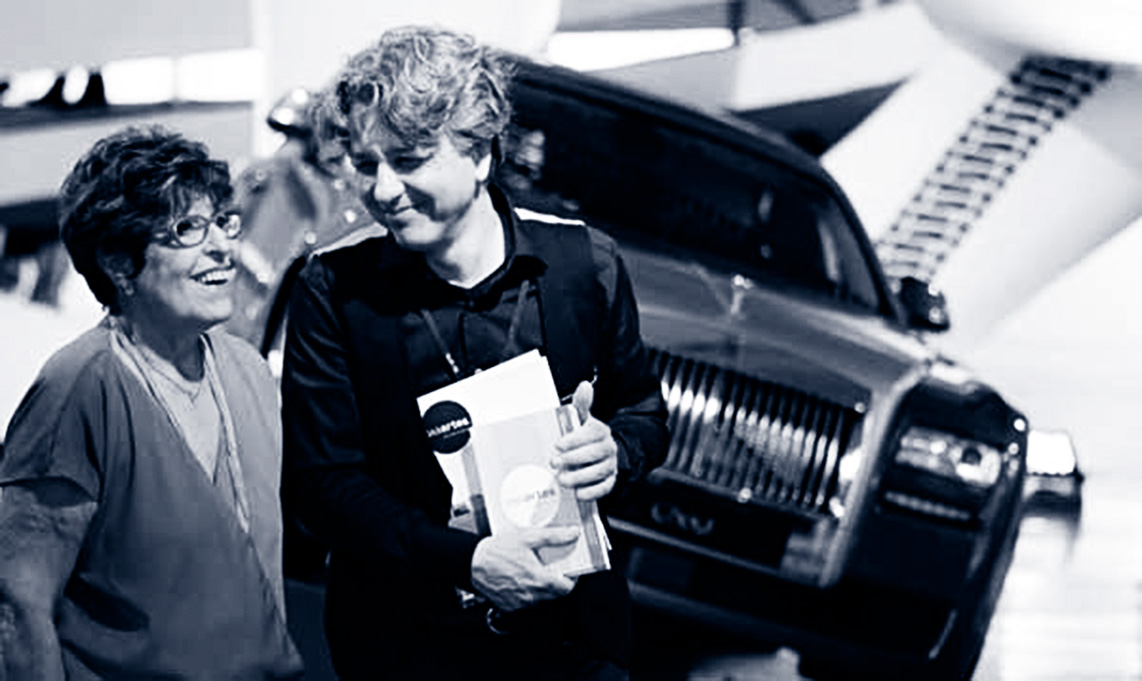
Rolling Tacks Project 2014, Sao Paulo
REGINA SILVEIRA . WILD HOUSE PROJECT . MAIN PALAIS. FRANKFURT. 10.OCTUBRE 2013 - 20. APRIL 2014
- Description
-
WILD HOUSE Project MAIN PALAIS . Frankfurt . Wild House belongs to the series of recent interventions aiming to virtually transform architectures, made by Brazilian artist Regina Silveira. In Wild House the graphic motif is an accumulation of animals footprints which fictionally run and invade the inside spaces of the Main House in Frankfurt. As if entering through the windows located along the internal staircases, the pattern is a mixture of several tracks left by incompatible species. The animals footprints were originally conceived for Tropel (Sao Paulo Biennial, 1998) a facade ephemeral piece that evoked concepts of cultural devoration present in Antropophagy, an artistitic and literary manifestation, largely influential in Brazilian Modernism. Wild House intends to be a sort of phantasmagorical event where the animals would have left their marks over the walls, and then disappeared. Technically made as cut vinyl adhered upon the curved walls of the staircases, the footprints motif appears again in Tracks (2011), a video animation with soundtrack, projected at the building’s basement. Altogether, Tropel and Tracks want to bring the suggestion of a sudden and uncanny invasion of the Main Palais building. Other works from Regina Silveira will be on view, such as prints and wooden models, as well as video docmentaries on some of her interventions over several architectural spaces, internationally, in the last years.
Making of by Regina · April 2014, SÃO PAULO
REGINA SILVEIRA · EL SUEÑO DE MIRRA Y OTRAS CONSTELACIONES · MUSEO AMPARO · PUEBLA, MÉXICO 01 FEBRERO - 16 JUNIO 2014
- Description
-
La arquitectura es de un modo fundamental, aunque quizás no evidente, un espacio de escritura. Por eso siempre dice algo, aunque se presente impoluta y traslúcida, como en el vestíbulo de este renovado Museo Amparo. Por eso es posible reescribir sobre ella, intervenirla para hacerla contar una historia distinta a la que narra. Un bordado no parece ser la mejor manera de contar otra historia. Sin embargo, como los muros blancos del museo, dice mucho al parecer no querer decir nada. ¿De qué nos habla su silencio? Es notorio el silencio histórico de las mujeres y el anonimato de sus formas de escritura. El bordado es un recordatorio de ello: no tiene autora y sirve las más de las veces de mero ornamento. Las historias meritorias, se nos ha dicho, se esculpen en mármol y se yerguen en monumentos con nombres y fechas. Sin embargo, los temas y las imágenes que se trenzan en el bordado son públicas y populares –motivos vegetales y animales, escenas cotidianas. Nada muy heroico: ninguna batalla ni ningún militar victorioso de familia de abolengo. El bordado cuenta su historia sin nombres propios. Lo que es llamativo, pues la narración local de la empresa textil no es anónima. Tiene una larga tradición en Puebla y se entreteje con su pasado más noble y el de algunos de sus hombres más connotados, que dan nombre a sus calles. El esplendor de la industria textil se da en el siglo XIX, precisamente cuando se populariza la imagen de la china poblana, de blusa bordada y rebozo, que es anónima como los motivos de un bordado. Toda arquitectura habla, pues, y cuenta su historia. Hay que interrogarla, al igual que la ciudad que habita. Por eso, las puntadas de este bordado imaginario, de este sueño de píxeles agigantados, se dan no sólo sobre las paredes del museo sino sobre la historia y el imaginario local. Hay que entrar en él y salir de él. Hay que continuar tejiéndolo pues está lleno de huecos y vacíos y olvidos. Aún muestra los flecos que están por enhebrarse. Son la mirada del espectador, su cuerpo y su memoria, los que tienen que hilarlos. Como cualquier historia, este bordado muestra tanto como oculta. Aquí sueña Mirra, Catarina de San Juan, una mujer cosida a la tradición local, que se ha convertido en personaje mítico y, por eso, fantasmagórico: está presente en la medida en que está ausente. Como el trabajo femenino y doméstico, como el bordado, como la memoria de formas y ensoñaciones colectivas que se inscriben ahora en estos muros. Alberto López Cuenca
